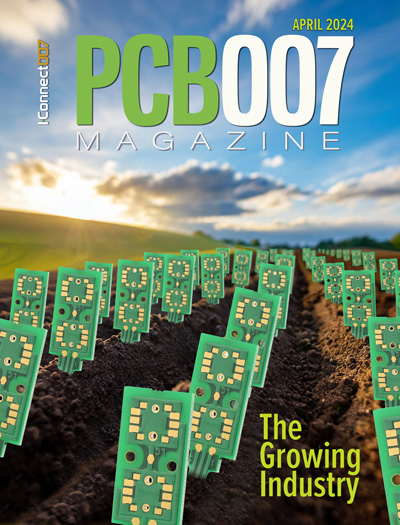-

- News
- Books
Featured Books
- pcb007 Magazine
Latest Issues
Current Issue
The Growing Industry
In this issue of PCB007 Magazine, we talk with leading economic experts, advocacy specialists in Washington, D.C., and PCB company leadership to get a well-rounded picture of what’s happening in the industry today. Don’t miss it.

The Sustainability Issue
Sustainability is one of the most widely used terms in business today, especially for electronics and manufacturing but what does it mean to you? We explore the environmental, business, and economic impacts.

The Fabricator’s Guide to IPC APEX EXPO
This issue previews many of the important events taking place at this year's show and highlights some changes and opportunities. So, buckle up. We are counting down to IPC APEX EXPO 2024.
- Articles
- Columns
Search Console
- Links
- Events
||| MENU - pcb007 Magazine
Using the Type 1 Gauge Study to Assess Measurement Capability
July 26, 2016 | Patrick Valentine, UYEMURA USAEstimated reading time: 1 minute
Measurement capability is a critical aspect of ensuring product quality, therefore a measurement system must be assessed before being used on products. Understanding how to assess measurement capability becomes critical. The Type 1 Gauge study is typically the first step in a measurement system analysis program. Type 1 Gauge parameters are explained, and a worked example using electroless nickel immersion gold (ENIG) is provided.
What Does the Type 1 Gauge Study Do? There are two major types of measurement system variation:
1. Accuracy is variation between the measurement and a true or reference value
2. Precision is variation between repeated measurements
A Type 1 Gauge study involves repeated measurements of one sample by one gauge and by one operator. With this information, the
Type 1 Gauge study provides an assessment of the following:
1. Accuracy, assuming a reference value is available
2. Precision of repeated measurements
Without an accepted reference value, the Type 1 Gauge study only measures precision, and accuracy becomes unavailable. Bias is a quantitative term used to describe accuracy. Bias is the difference between the average of measurements made on the reference value and its true value.
A Type 1 Gauge study considers only the inherent variation of the gauge itself. A Type 1 Gauge study isolates the effects of accuracy and precision, and evaluates the capability of the gauge to make accurate measurements with acceptable variability. A Type 1 Gauge study does not assess operator-to-operator or gaugeto-gauge variation. A more complex gauge repeatability and reproducibility (R&R) study is indicated for a more comprehensive measurement system analysis.
To read this entire article, which appeared in the July 2016 issue of The PCB Magazine, click here.
Suggested Items
Siemens’ Breakthrough Veloce CS Transforms Emulation and Prototyping with Three Novel Products
04/24/2024 | Siemens Digital Industries SoftwareSiemens Digital Industries Software launched the Veloce™ CS hardware-assisted verification and validation system. In a first for the EDA (Electronic Design Automation) industry, Veloce CS incorporates hardware emulation, enterprise prototyping and software prototyping and is built on two highly advanced integrated circuits (ICs) – Siemens’ new, purpose-built Crystal accelerator chip for emulation and the AMD Versal™ Premium VP1902 FPGA adaptive SoC (System-on-a-chip) for enterprise and software prototyping.
Vicor Power Orders Hentec Industries/RPS Automation Pulsar Solderability Testing System
04/24/2024 | Hentec Industries/RPS AutomationHentec Industries/RPS Automation, a leading manufacturer of selective soldering, lead tinning and solderability test equipment, is pleased to announce that Vicor Power has finalized the purchase of a Pulsar solderability testing system.
Lockheed Martin Successfully Transitions Long Range Discrimination Radar To The Missile Defense Agency
04/23/2024 | Lockheed MartinThe Long Range Discrimination Radar (LRDR) at Clear Space Force Station in Clear, Alaska, completed DD250 final acceptance and was officially handed over to the Missile Defense Agency in preparation for an Operational Capability Baseline (OCB) decision and final transition to the Warfighter. In addition, prior to this transition, the system has started Space Domain Awareness data collects for the United States Space Force.
US Department of Defense Selects Intel Foundry for Phase Three of RAMP-C
04/23/2024 | IntelThe U.S. Department of Defense (DoD) has awarded Intel Foundry Phase Three of its Rapid Assured Microelectronics Prototypes - Commercial (RAMP-C) program.
Real Time with... IPC APEX EXPO 2024: AI Implementation at Omron
04/18/2024 | Real Time with...IPC APEX EXPOEditor Nolan Johnson and Omron Product Manager Nick Fieldhouse discuss the company's focus on AI implementation to enhance customer experience and results. They address programming challenges and how AI can help customers achieve better outcomes with less experience. Omron's AI is compatible with existing systems, facilitating easy upgrades.


